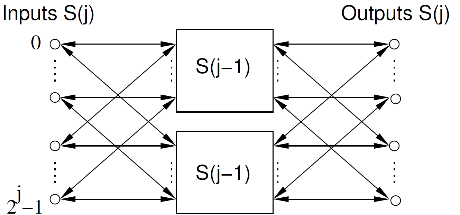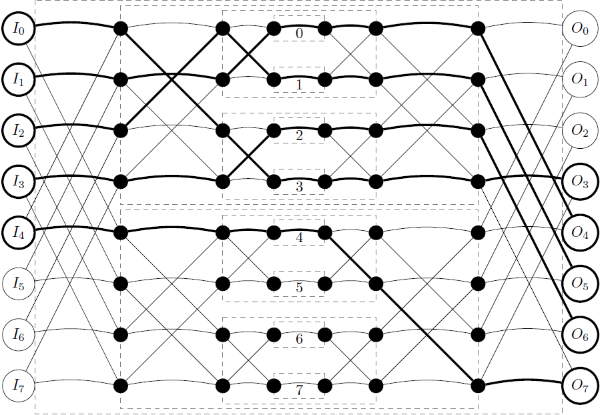Telephone Network
A telephone company wants to build a new telephone network in a city. The company has the goal that each person in the city should be able to call each other person. Of course, it is not possible to build direct connections between every pair of persons. Instead, the company uses a network made up of several layers.
We denote a network switch in layer j by S(j). A switch S(0) consists of one input, one output and a cable connecting the input to the output. A switch S(j) with j > 0 consists of 2j inputs, 2j outputs and two switches S(j−1). Input i of S(j) (0 ≤ i < 2j) is connected via a cable to the inputs i mod 2j−1 of each of the two switches S(j−1). Similarly, output i of S(j) is connected to the outputs i mod 2j−1 of each of the two switches S(j−1).
一个电话公司想在城市中搭建一个电话网络,他们的目标是让每两个人之间都能够通话。当然,在每两个用户之间直接搭一根电话线是不大可能的事情。于是公司采用了分层网络来解决这个问题。我们令第j层网络由开关S(j)来控制。开关S(0)包含一个输入,一个输出和一条将输入和输出连起来的电话线。开关S(j) (j>0)包含2j 个输入,2j 个输出和两个S(j-1)级的开关。S(j)的第i个输入是用线连接到S(j-1)的 i mod 2j−1 上。同样,输出也是这么连接的。

We are considering a network with one switch S(n) in the outermost layer. It can be shown that any input and output of switch S(n) has a unique connection path to any of the S(0) switches. Therefore, any input of S(n) can be connected to any of its outputs, and the connection path is uniquely determined by specifying through which switch S(0) the connection is established.
We number the switches S(0) belonging to the switch S(n) from 0 to 2n−1. The i-th switch S(0) is defined as follows. Write the number i in binary as bn−1bn−2…b0. This defines a path from an input of S(n) to the i-th switch S(0) via the following procedure: for each j, bj=0 indicates that the path extends from S(j+1) to the first S(j) switch to which it is directly connected, and bj=1 indicates that the path extends to the second S(j) switch. Note that regardless of which input of S(n) is selected, this path arrives at the same S(0) switch, which is given the number i. See also the figure below the sample data for details of how the numbering works.
Sometimes multiple connections are needed at the same time. In order to avoid interference, each of the inputs and outputs of all switches S(j) (0 ≤ j ≤ n) can be used by at most one connection. Given a set of connection requests, can you find connection paths for each request such that the connection paths are disjoint?
最外层网络只有一个开关S(n)。对已S(n)的任意一个输入和输出,他们都有一条独特的路径连接到S(0)。因此,任意一个输入和输出就能够连接起来,而且这样的路径是独一无二的有连接到S(0)的路径决定的。我们将S(n)的2n 个S(0)级开关标号为0- 2n−1。第i个开关的定义为:将i写成二进制 bn−1bn−2…b0. 。S(n)到S(0)的路径是这么确定的:对于每一位j,bj=0 就表示S(J+1)连接到第一个S(j)开关,否则连接到第二个S(j)开关。对于给定的i,无论开关S(n)的输入是什么,这个路径必须到达同一个S(0)开关。不懂的就好好看样例。有时候多组连接必须同时使用,为了防止交叉干扰,每个开关只能在这些通话中使用一次。给你一些通话需求,你能找到满足所有要求且不相交的路径么?


